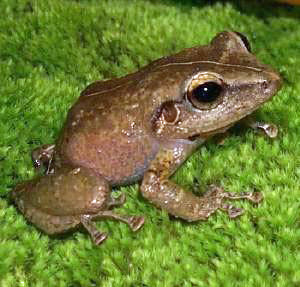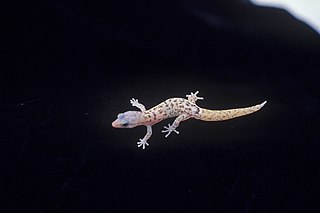Related Research Articles

The Puerto Rican dry forests are a tropical dry forest ecoregion located in southwestern and eastern Puerto Rico and on the offshore islands. They cover an area of 1,300 km2 (500 sq mi). These forests grow in areas receiving less than 1,000 mm (39 in) of rain annually. Many of the trees are deciduous, losing their leaves during the dry season which normally lasts from December to April.

The common coquí or coquí is a species of frog endemic to Puerto Rico belonging to the family Eleutherodactylidae. The species is named for the loud call the males make at night. This sound serves two purposes. "CO" serves to repel males and establish territory while the "KEE" serves to attract females. Since the auditory systems of males and females respond preferentially to different notes of the male call, this is an example of a sex difference in a sensory system. The common coquí is a very important aspect of Puerto Rican culture, and it has become an unofficial territorial symbol of Puerto Rico.

Eleutherodactylus is a genus of frogs in the family Eleutherodactylidae. Many of the 200 species of the genus are commonly known as "rain frogs" or "robber frogs", due to their sharp, high-pitched, insect-like calls.

The Puerto Rican spindalis is a bird endemic to the island of Puerto Rico, where it is commonly known as reina mora. The species is widely distributed throughout the island and is an important part of the Puerto Rican ecosystem because of its help in seed dispersal and plant reproduction. The Puerto Rican spindalis has been proposed as the national bird of Puerto Rico.

The Monito gecko is a lizard, a species of gecko endemic to the island of Monito, in the archipelago of Puerto Rico.

The St. Croix macaw or Puerto Rican macaw, is an extinct species of macaw whose remains have been found on the Caribbean islands of St. Croix and Puerto Rico. It was described in 1937 based on a tibiotarsus leg bone unearthed from a kitchen midden at a pre-Columbian site on St. Croix. A second specimen consisting of various bones from a similar site on Puerto Rico was described in 2008, while a coracoid from Montserrat may belong to this or another extinct species of macaw. The St. Croix macaw is one of 13 extinct macaw species that have been proposed to have lived on the Caribbean islands. Macaws were frequently transported long distances by humans in prehistoric and historical times, so it is impossible to know whether species known only from bones or accounts were native or imported.

The web-footed coqui, stream coqui, Puerto Rican stream frog, or Karl's robber frog, Eleutherodactylus karlschmidti, is a possibly extinct Puerto Rican frog species in the family Eleutherodactylidae. It was first described by Chapman Grant in 1931, and was named after herpetologist Karl Patterson Schmidt. It is the largest Eleutherodactylus species of Puerto Rico.

The fauna of Puerto Rico is similar to other island archipelago faunas, with high endemism, and low, skewed taxonomic diversity. Bats are the only extant native terrestrial mammals in Puerto Rico. All other terrestrial mammals in the area were introduced by humans, and include species such as cats, goats, sheep, the small Asian mongoose, and escaped monkeys. Marine mammals include dolphins, manatees, and whales. Of the 349 bird species, about 120 breed in the archipelago, and 47.5% are accidental or rare.

The Antillean fruit-eating bat is one of two leaf-nosed bat species belonging to the genus Brachyphylla. The species occurs in the Caribbean from Puerto Rico to St. Vincent and Barbados. Fossil specimens have also been recorded from New Providence, Bahamas.
The Puerto Rican sand crab, Emerita portoricensis, is a species of "sand crab" belonging to the genus Emerita, which is native to the main island of Puerto Rico and its archipelago. The most detailed study conducted on the species was conducted by Sastre between 1988 and 1992. This investigation determined that the species has diotic traits and that there are size and survival differences between sexes. Both sexes reach sexual maturity three months after birth. At this age females are 7 mm (¼ in) in length; their maximum shell size is 19 mm (¾ in). The growing rate is slower in male specimens these being only 5 mm in length when they reach sexual maturity with a maximum shell size of 11 mm (½ in). In terms of reproductive aspects, females fecundity increases with their size, the males reproductive contribution decreases as they grow older.

Eneida's coquí is a species of coquí, a small variety of frog endemic to the main island of Puerto Rico and its archipelago. Known as coquí de Eneida in Puerto Rico, this amphibian is mainly terrestrial. Its average adult size is from 1.0 to 1.2 inches. It has a number of small warts located across its back and eyelids. Its main color is a light tone of greenish or grayish brown with a yellow tint on its underbelly. They often have a pair of light colored concave lines located on their backs. Their eyes are golden or green colored, generally dark colored with black venal reticulation. Its habitat is located in mountains that are 1,000 to 3,000 feet above sea level. This species seems to have suffered a population reduction, in the process disappearing from areas formerly considered its natural habitat. The reason behind this reduction is under study, and Eneida's coquí has been designated an endangered species until the cause is discovered. This population decrease is not considered to be linked with the loss of its habitat, which has prevented the protection of its habitat.
The locust coqui is a species of frog in the family Eleutherodactylidae endemic to Puerto Rico. Its natural habitats are subtropical or tropical moist lowland forests and subtropical or tropical moist montane forests. E. locustus has suffered a population decline of more than 80% due to introduced predators and amphibian chytrid disease. Scientists believe amphibian chytrid disease may be exacerbated by climate change - warmer temperatures in dry, moist habitats, causing stress that may lead to greater susceptibility to the disease.

Leptodactylus albilabris is a species of frog in the family Leptodactylidae. Its local name is ranita de labio blanco or sapito de labio blanco and English name either Gunther's white-lipped frog or Hispaniolan ditch frog. It is found in Hispaniola, Puerto Rico, the British Virgin Islands, and the U.S. Virgin Islands.

Leach's single leaf bat, also known as Greater Antillean long-tongued bat, is a species of bat in the family Phyllostomidae. It is found in southern Bahamas, Cuba, Jamaica, Hispaniola, and Puerto Rico. It forms large colonies, with up to a few hundred thousand individuals, and feeds on a relatively wide variety of food items including pollen, nectar, fruit and insects.

The red fruit bat or red fig-eating bat is a species of bat in the family Phyllostomidae, in the monotypic genus Stenoderma. It is found in Puerto Rico and the U.S. Virgin Islands.

Helicina guppyi is a species of tropical land snail with an operculum, a terrestrial gastropod mollusk in the family Helicinidae.
Sphaerodactylus klauberi is a species of gecko, a lizard in the family Sphaerodactylidae The species is endemic to the archipelago of Puerto Rico.

The Puerto Rican crow is an extinct crow species in the family Corvidae that was endemic to Puerto Rico and the United States Virgin Islands. Little is known about its habitat, but it possibly died out after the colonization of humans on these islands.

The Sierra de Luquillo is a mountain range located in the northeastern part of Puerto Rico. Also known as the Luquillo Mountains, these are steep-sided, densely-forested mountains rising to elevations of around 1,075 m (3,527 ft), the highest point being the summit of El Toro, closely followed by that of Pico El Yunque.
References
- ↑ Heller J.: Life History Strategies. in Barker G. M. (ed.): The biology of terrestrial molluscs . CABI Publishing, Oxon, UK, 2001, ISBN 0-85199-318-4. 1-146, cited page: 428.